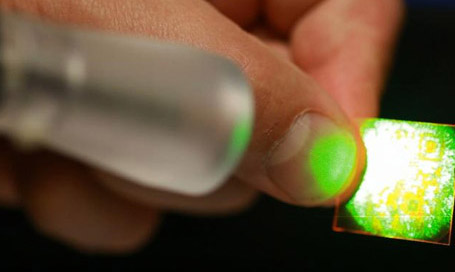A new method that prints unique images to identify counterfeit goods has been developed by researchers at the University of Cambridge, who say that their technology could make a wide range of products – from currency to pharmaceuticals – more resistant to fraud.
The method, which uses innovative printed optical materials, was developed within the University’s Electrical Engineering Division, led by physicist and engineer Dr Damian Gardiner, and supported by Cambridge Enterprise. The technology uses liquid crystal ink (made from molecules that form helical patterns) that can be inkjet-printed onto nearly any surface and dynamically encoded on the fly.
Inkjet printing provides a very precise level of control over the material’s pattern and functionality. The technology allows different kinds of features to be created – ranging from simple hologram-like patterns designed for the general public to authenticate, through to those that are used for high-security and need expensive, specialised equipment.
Unlike traditional security holograms, which are fundamentally identical, the new printing method marries optical materials and variable inkjet printing in a way that creates unique images. Using a dedicated reader, the images can emit pure laser light with a specific signature – the image size can be below that visible to the unaided eye. The technology is unique in offering brand owners overt, covert and forensic authentication in one easily applied print feature.
Every year, hundreds of thousands of people are sold fake pharmaceuticals under the mistaken belief that they will help them, while counterfeit products cost companies hundreds of billions of pounds. We think that our printed lasers could be used to protect both products and people.
Dr Damian Gardiner
Because lasers can be printed onto all kinds of surfaces – plastic, paper, metal and glass, among them – the new technique could be used to authenticate a wide range of products. Fake pharmaceuticals are a particular concern globally. Potential markets range from high-value consumer goods and currency to pharmaceuticals.
“Every year, hundreds of thousands of people are sold fake pharmaceuticals under the mistaken belief that they will help them, while counterfeit products cost companies hundreds of billions of pounds,” Gardiner said. “We think that our printed lasers could be used to protect both products and people.”
The technology was adopted early in 2015 by Tracerco Ltd, an industrial technology company providing unique and specialised detection, diagnostic and measurement solutions and part of the Johnson Matthey group. Tracerco are now building upon the technical foundations to bring the technology to market readiness. The technology offers multiple levels of authentication – ranging from so-called overt features for non-specialists, right through to high-level, forensic elements where the printed material itself emits laser light.
Typical of many technology developments, the project took time to get off the ground. Research began in 2006 in Professor Harry Coles’ group, funded by the Engineering and Physical Research Council (EPSRC), that focused on the development of micron-sized tuneable lasers, for example to produce tuneable colours and patterns for use in various applications such as medical diagnostics.
Cambridge Enterprise became involved with exploring commercialisation of the results in 2008, and provided patent funding and support to Dr Gardiner and his colleagues to help to identify possible routes forward, including the commissioning of market research by an external consultancy. As the research continued, the team was awarded further funding to drive the commercialisation of the results, including additional funding from EPSRC and the Cambridge Integrated Knowledge Centre (CIKC), which led to a pivot in the commercial direction.
With attention shifted away from the lasers themselves to techniques to apply and interrogate the smart ink, Dr Gardiner was awarded a Royal Academy of Engineering Enterprise Fellowship by the Royal Academy of Engineering through their Enterprise Hub and Enterprise Fellowship Scheme.
Cambridge Enterprise assisted Dr Gardiner and his colleagues during this phase through continued funding for the patents protecting this technology, and also by providing support for Dr Gardiner’s Enterprise Fellowship application. The subsequent commercial focus, enabled by the Enterprise Fellowship and the founding of a company ilumink to develop the technology further, has begun the successful translation of University research into a real product – a major step in the development of the research begun 10 years previously.




